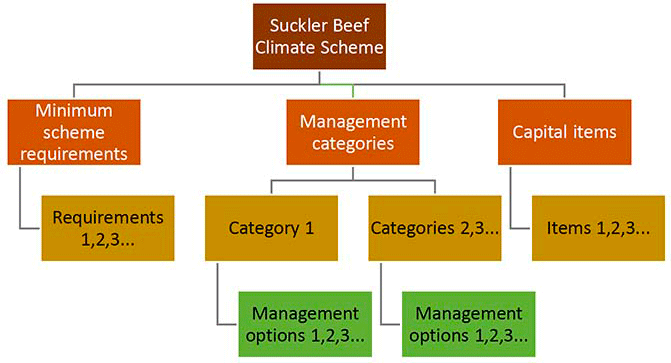Suckler Beef Climate Scheme: final report
Final report from the Suckler Beef Climate Group on development and delivery recommendations for sustainable suckler beef production in Scotland.
5. Scheme overview
The SBCS is designed to be an outcome-based support mechanism and aims to encourage the uptake or continuation of best practice where significant benefits can be delivered to assist businesses in reaching their efficiency and environmental potential.
It is proposed that there are three major components to the scheme, namely the minimum requirements that participants must meet at the start and throughout the duration of the scheme, the management categories which each contain a collection of different optional management options for participants to choose from and commit to, and the capital items which can be accessed and claimed by committing to the relevant management options.
Broadly speaking, the scheme would consist of the following individual components:

Participants can customise the scheme and choose their level of commitment in order to ultimately increase the effectiveness and impact of any adopted management activities. This structure should provide sufficient flexibility to tailor the various management activities to individual production systems by allowing different types of businesses to commit to and carry out on-farm actions and management that are relevant to their specific farm structure and environment, and which can be incorporated into their cattle enterprise to achieve real outcomes. The chosen approach is hoped to enable and encourage a wide uptake of the scheme amongst Scottish suckler beef producers by not being too prescriptive, and aims to reduce barriers to participation on grounds of business type, location and cattle system.
Recognising that a future agricultural support system will put a greater emphasis on delivering environmental goods and should take a more outcome-based approach, the SBCS should be designed with sufficient flexibility and potential for adaptation to allow the modification of the scheme for incorporation into a future support scheme, whether that will be as part of a voluntary or compulsory scheme, and delivered through Pillar I or Pillar II.
Rather than designing the scheme as one fixed unit, it is therefore proposed that the scheme be developed as independently developed and stacked components that can easily be interlinked, combined and moved, thereby making any future adjustments to the scheme a simpler, cheaper and less time-consuming process.
The following chapters outline the proposed minimum requirements, management categories and options, and capital items that should be considered for inclusion in the SBCS.
Contact
Email: alistair.prior@gov.scot
There is a problem
Thanks for your feedback